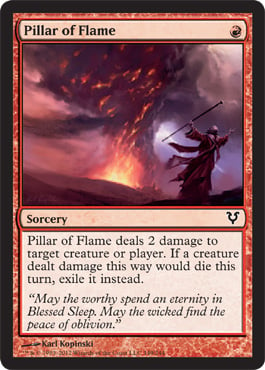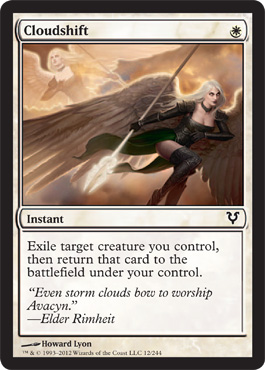But what does a new set mean for us, as deckbuilders?
Obviously, there's going to be shakeups to the metagame. Last time we had a set
release, we got powerhouses like Wolfir Silverheart and Zealous Conscripts.
People wondered at the potential power lurking in the 4 mana Restoration Angel,
and many other cards saw hype rise and fall. With every new set comes the same
question asked over two hundred times.
Is this card any good?
The Formula for Good Cards
When I started playing Magic, way-back-when in 5th Edition,
we had a pretty simple formula for determining if a creature was good. Add
together their power and toughness, divide by two, then add one for each
ability that the creature had. That should be its mana cost. So a 1/1 should
cost 1, and a 1/1 with flying should be two.
We were not exactly world-class planeswalkers, you may have
guessed.
Sadly, there is no cut and dry formula for deciding if a card
is any good, because each card is good or bad purely in context of other cards.
Stromkirk Noble is a staple of a Standard Red Aggressive deck, but you wouldn’t
dream of seeing it in Legacy. With a much larger card pool, we have more
options for our decks, and so weaker cards get culled more easily. Why play a
1/1 that needs to attack multiple times in our one mana slot when we can just
play Goblin Guide? Have you seen
Goblin Guide? That guy is insane!

But that’s not the only concern. If that was the case, each format would just replace the appropriate cards with ‘upgrades’. Fortunately for us, Magic is a complex game that has interactions beyond simple ‘better’ and ‘worse’. For an example, let’s take a look at Mental Misstep. You may have seen this card in the sideboard of a few standard decks, mostly in – or to fight against – Delver decks. Because their decks are so heavily-laden with one-cost spells, Mental Misstep is a powerful weapon against them, but lackluster against many other decks. It is an appropriately powerful card in this format, and sees some sideboard play. Great!
Take the same card in the Legacy format though, and you get a
metagame warping monstrosity. Mental Misstep single handedly twisted the
metagame until you either constructed your deck with 4 of them, or you didn’t
play one-drops to make your opponent’s Missteps worth it. Because the
individual cards in Legacy are so powerful, Mental Misstep’s negligible cost
becomes far more worth it. Why spend two life in Standard to stop a 1/1
attacker? You wouldn’t. In Legacy, that same creature is likely a 2/2 with
haste, or a Mother of Runes. When your answer is stopping a much more powerful
card, it becomes more valuable itself.
It didn’t take long for Wizards to pull the plug and ban Mental
Misstep in Legacy. It was on the inaugural ban list for Modern as well, because
Wizards feared the pressure that it would put on beatdown decks. Yet at the
same time, it still sees only sporadic sideboard play in Standard.
Making the Call
How can we decide where a card falls on the power spectrum? It
depends what the card is designed to do.
For threats – cards that
are designed to help end the game, the math is generally pretty simple. We want
a card that puts significant pressure on your opponent for an appropriate cost.
A recent icon of this would be something like Champion of the Parish. While he’s
only a 1/1 on his face, he costs 1 mana, which allows a lot of flexibility in
casting him. More, he grows, and can grow quickly into a large threat. Gather
the Townsfolk allows you to attack for 3 damage on the second turn, which is a
mark not often allowed in Magic because it puts so much pressure on the
opponent. This is generally powerful, and allows our 1 mana spell to demand an
answer from our opponent. If they don’t have one, they will take a lot of
damage quickly.
The math is a little
more complicated when it comes to answers. Is Shock good? Probably not in a
format with Lightning Bolt, but if there’s no other burn spell at one mana, and
Stoneforge Mystic is running rampant, we could certainly consider it.
Which is better?
Galvanic Blast or Pillar of Flame? Welcome to a complex question that RG Aggro
has been dealing with for over a month now. Galvanic Blast’s metalcraft is only
rarely relevant at the moment, because RG Aggro doesn’t tend to run many
artifacts, so the argument boils down to “Is Instant Speed better than Exiling
creatures instead of killing them?”
Or perhaps more succinctly:
“How many creatures
with Undying do you expect to see?”
At the moment, I’d
lean towards Pillar of Flame in the majority of cases. It’s less good against
Delver, but still very serviceable. On the other hand, it provides huge gains
against Zombies and Blood Artist decks, which have been increasing in
popularity lately with their success on the Star City Games circuit. It also
does good work against Strangleroot Geist.
Historical Context
An aside here –
evaluating cards often happens in a historical context. When a card is first
spoiled, many people’s first instinct is to compare it to previous versions of
similar effects. Take Cloudshift – is a flicker effect worth one mana and a
card? (Always consider that effects cost you a card in your hand! That is a
limited resource.) Let’s look at previous versions of similar effects.
Saving Grasp allows a number of similar interactions. It lets us re-use our Enter-The-Battlefield triggers, but forces us to re-pay the creature’s cost. It can blank a removal spell like Cloudshift, but forces us into two colors. Most importantly, it gives us two uses. Overall, the two are similar in scope, if not power. Cloudshift is more of a hyper-efficient cost/effect, where Saving Grasp does a number of things that we might not necessarily want – like forcing us to repay full-cost for a creature.
Another example
could be Griselbrand. Aside from being a 7/7 flying lifelink, his ability is
very reminiscent of Necropotence. Since Necropotence was a tournament
dominating card during it’s time, we would be remiss to not give Griselbrand
his due as a possible threat. While his mana cost of 8 is very restrictive,
there are reanimation effects. The question then becomes: Are the hoops we need
to jump through to get Griselbrand in play worth being able to play with a
virtual Necropotence?
Spoiler Alert: Oh yea.
That’s Bad Right Now
Let’s take a look at
a powerful card. Its name is Hero of Bladehold, and it’s a 3/4 for 4 mana. When
it attacks, it gives our attackers a modest +1/+0 bonus, and also creates two
creatures. That appears powerful. A 4 mana creature that attacks for 7 damage
among 3 creatures (and 11 the following turn if nothing interferes!) is
significant and capable of ending the game itself. It has 4 toughness, well out
of range of the majority of burn spells. It is a staple in a number of
aggressive decks, and often ends the game.
It’s also terrible
more often than not.
Hero of Bladehold is
a 4 mana spell, which is already on the higher-end for an aggressive deck. It requires
a lot of things to go right in order for it to do its job optimally. You need
to do the following:
-Survive until your
turn 4
-Have 4 mana,
including two white
-Cast the spell
without it being countered
-Have the creature
(and you) survive until turn 5’s combat phase.
-Opponent cannot
have a creature bigger than a 3/4.
It may not seem
especially difficult, but when a deck like Delver is capable of chaining 3-4
vapor snags, one after another, then it seems less good. Hero of Bladehold is a
spectacular creature in the abstract, but it fails when exposed to an actual
environment. A cost of 4 mana presents perfect timing to walk into a board wipe
against your aggressive deck. Hero has no relevant protection from removal,
which has caused it to wane in popularity often whenever there is a ‘test’ card.
Jace, the Mind Sculptor, Dismember, and Vapor Snag are all real problems for
it.
We need to keep this
in mind when deciding the relative value of a card. This should not be confused
with the ‘dies to removal’ argument. There are many people on forums who will
argue that if a creature can die to removal, it is useless.
Dies to Removal
Creatures can be
removed from the battlefield. This is a truth of the game. There are very few
creatures out there that don’t die to removal, and they tend to either be
absurdly expensive, or have some other manner of drawback. We should keep this
in mind when evaluating cards, but it should not be the limit of our argument.
Yes – Restoration Angel is powerful because it gives us significant value even
if our opponent has a Doom Blade, but that does not mean that Wolfir
Silverheart is a bad card. No matter how you slice it, Silverheart is often
worth 12 power and toughness for 5 mana, spread over two creatures.
I plug that into my 5th
Edition calculator, and it breaks because it’s more than twice as powerful as
it ‘should’ be.
‘Dies to Removal’ is
an argument, but it needs to be weighed against the relative power of the card.
Remember, Deceiver Exarch dies to removal as well, but that doesn’t matter when
your card effectively reads “During your upkeep, if you have a card named
Splinter Twin in your hand, you win the game.”
Sure, it dies to
removal – or you win. That seems like a fair deal for 3 mana. I’d love to do
that a few times every game. I dare say that I’d probably win with it a few
times.
Exercise of the Day:
Here’s what I want
you to do. Look at a deck – preferably one that you play on a regular basis.
Pick a card in it, and then explain why it is powerful, and why it deserves a
spot in your deck.
Try to place it in
the context of the format you play– Standard, Legacy, or even Casual. This
could be as simple as “I run Leyline of Punishment because I play casually and
two of my friends gain a lot of life” or as complex as running Uvenwald Tracker
in Legacy Maverick because of considerations with the mirror matchup.






No comments:
Post a Comment